Abstract
Isoprinosine has been reported to decrease progression to AIDS, primarily by preventing Pneumocystis carinii pneumonia (PCP), in human immunodeficiency virus-infected patients, but the mechanism of action is unknown. para-Acetamidobenzoic acid (PAcBA), one component of isoprinosine, is structurally related to para-aminobenzoic acid (PABA), a precursor of de novo folate synthesis. This pathway is known to be important for P. carinii because sulfonamides, which are effective anti-P. carinii agents, inhibit incorporation of PABA into folate precursors by the enzyme dihydropteroate synthetase (DHPS). Inhibition of P. carinii DHPS by PAcBA was investigated by using two assays. In short-term cultures of P. carinii from rats, [3H]PABA incorporation into reduced folates was inhibited by both isoprinosine (mean +/- standard error 50% inhibitory concentration [IC50], 20 +/- 8.4 microM) and PAcBA free acid (IC50, 240 +/- 100 microM); a soluble PAcBA salt was more potent than PAcBA free acid alone (IC50, 29 +/- 48 microM). The activity of PAcBA free acid was confirmed in a cell-free DHPS inhibition assay (IC50, 120 +/- 120 microM). Inosine and dimethylaminopropanol, two other components of isoprinosine, were poor inhibitors of PABA incorporation (IC50, > 1,000 microM). PAcBA free acid also showed activity in inhibiting the DHPS of Toxoplasma gondii, but was a poor inhibitor of the DHPSs of Escherichia coli and Saccharomyces cerevisiae. In a rat model of PCP, the PAcBA salt administered intraperitoneally demonstrated no activity against established PCP either alone or when used in combination with trimethoprim; the lack of efficacy in this model may be due to the rapid metabolism of the drug. Prevention of PCP by PaCBA through inhibition of P. carinii DHPS may explain the activity of isoprinosine in decreasing the progression to AIDS in human immunodeficiency virus-infected patients.
Full text
PDF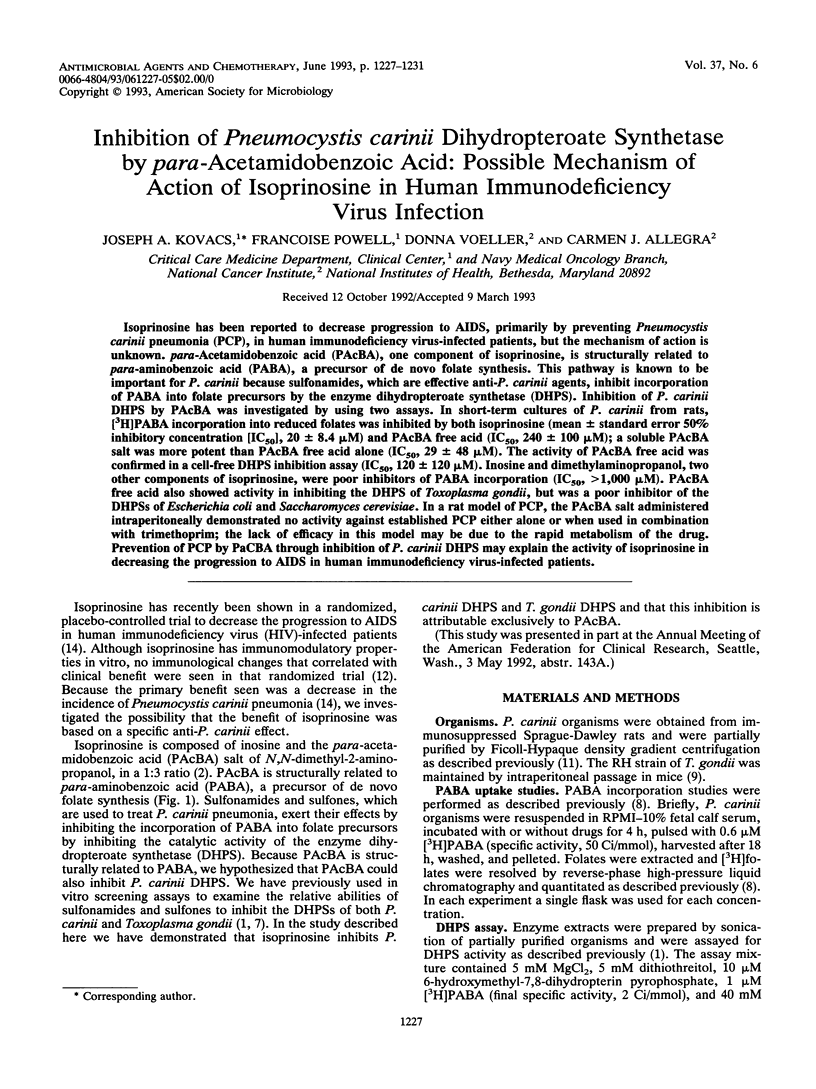
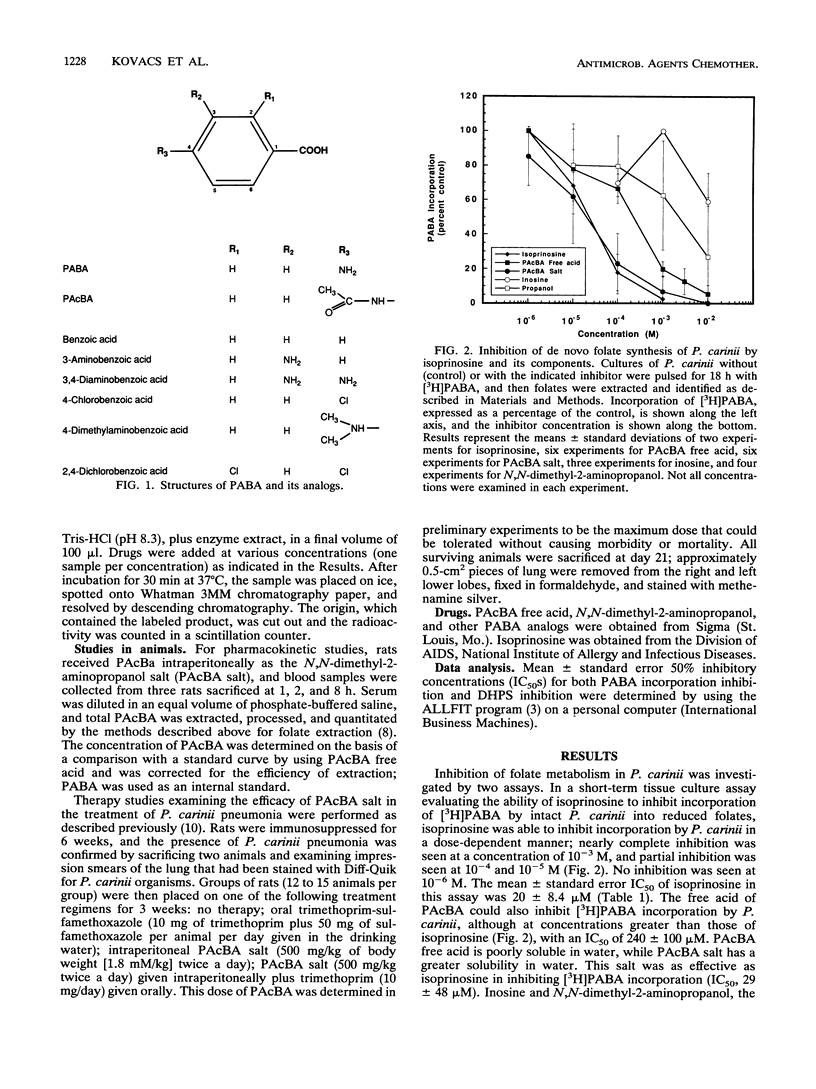
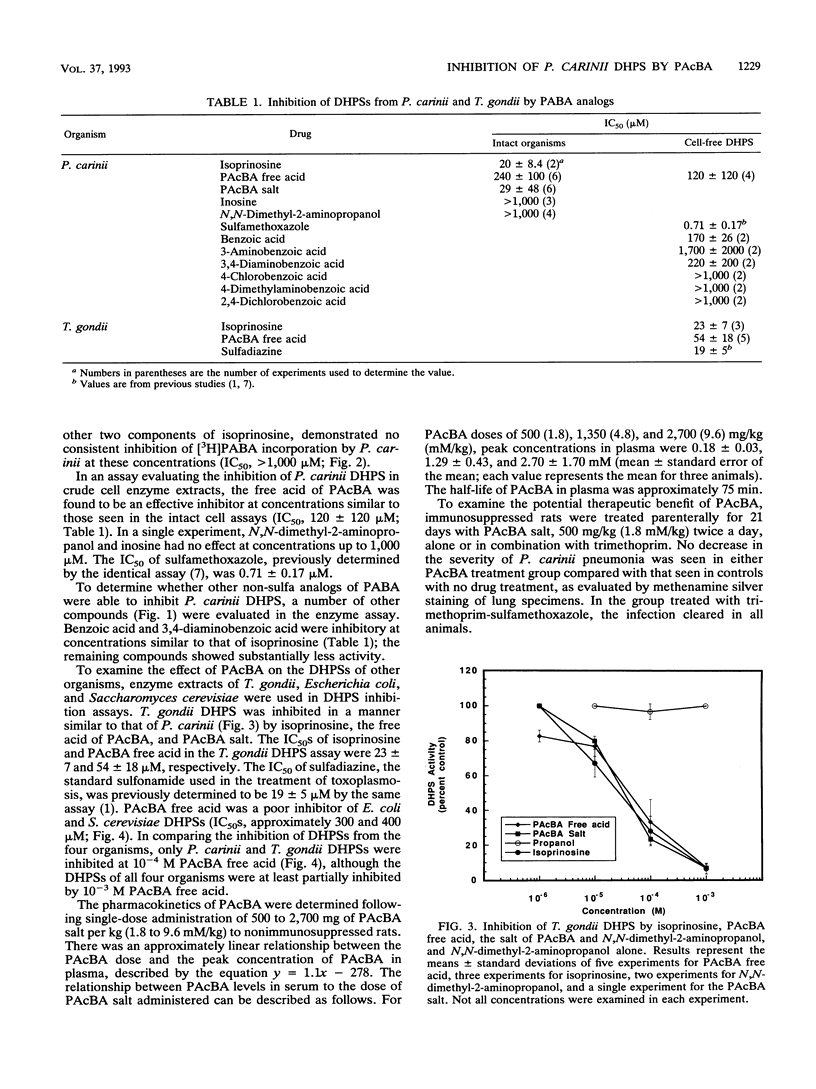
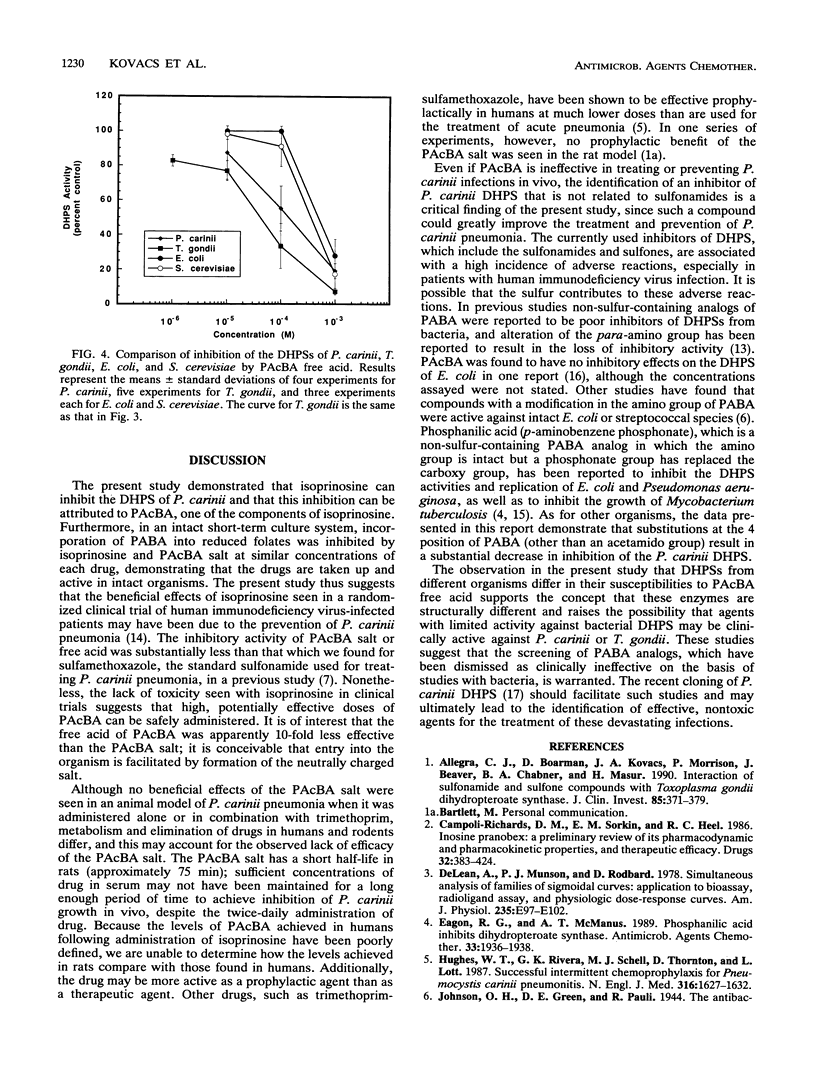
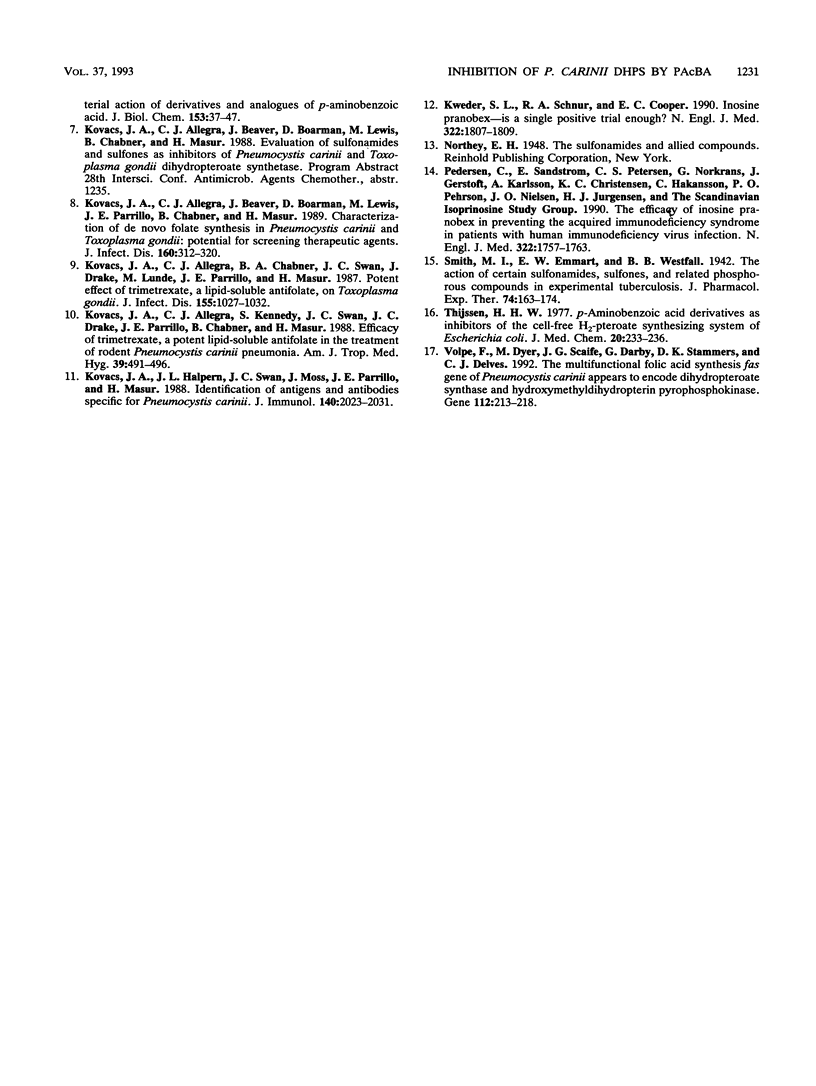
Selected References
These references are in PubMed. This may not be the complete list of references from this article.
- Allegra C. J., Boarman D., Kovacs J. A., Morrison P., Beaver J., Chabner B. A., Masur H. Interaction of sulfonamide and sulfone compounds with Toxoplasma gondii dihydropteroate synthase. J Clin Invest. 1990 Feb;85(2):371–379. doi: 10.1172/JCI114448. [DOI] [PMC free article] [PubMed] [Google Scholar]
- Campoli-Richards D. M., Sorkin E. M., Heel R. C. Inosine pranobex. A preliminary review of its pharmacodynamic and pharmacokinetic properties, and therapeutic efficacy. Drugs. 1986 Nov;32(5):383–424. doi: 10.2165/00003495-198632050-00001. [DOI] [PubMed] [Google Scholar]
- DeLean A., Munson P. J., Rodbard D. Simultaneous analysis of families of sigmoidal curves: application to bioassay, radioligand assay, and physiological dose-response curves. Am J Physiol. 1978 Aug;235(2):E97–102. doi: 10.1152/ajpendo.1978.235.2.E97. [DOI] [PubMed] [Google Scholar]
- Eagon R. G., McManus A. T. Phosphanilic acid inhibits dihydropteroate synthase. Antimicrob Agents Chemother. 1989 Nov;33(11):1936–1938. doi: 10.1128/aac.33.11.1936. [DOI] [PMC free article] [PubMed] [Google Scholar]
- Hughes W. T., Rivera G. K., Schell M. J., Thornton D., Lott L. Successful intermittent chemoprophylaxis for Pneumocystis carinii pneumonitis. N Engl J Med. 1987 Jun 25;316(26):1627–1632. doi: 10.1056/NEJM198706253162604. [DOI] [PubMed] [Google Scholar]
- Kovacs J. A., Allegra C. J., Beaver J., Boarman D., Lewis M., Parrillo J. E., Chabner B., Masur H. Characterization of de novo folate synthesis in Pneumocystis carinii and Toxoplasma gondii: potential for screening therapeutic agents. J Infect Dis. 1989 Aug;160(2):312–320. doi: 10.1093/infdis/160.2.312. [DOI] [PubMed] [Google Scholar]
- Kovacs J. A., Allegra C. J., Chabner B. A., Swan J. C., Drake J., Lunde M., Parrillo J. E., Masur H. Potent effect of trimetrexate, a lipid-soluble antifolate, on Toxoplasma gondii. J Infect Dis. 1987 May;155(5):1027–1032. doi: 10.1093/infdis/155.5.1027. [DOI] [PubMed] [Google Scholar]
- Kovacs J. A., Allegra C. J., Kennedy S., Swan J. C., Drake J., Parrillo J. E., Chabner B., Masur H. Efficacy of trimetrexate, a potent lipid-soluble antifolate, in the treatment of rodent Pneumocystis carinii pneumonia. Am J Trop Med Hyg. 1988 Nov;39(5):491–496. doi: 10.4269/ajtmh.1988.39.491. [DOI] [PubMed] [Google Scholar]
- Kovacs J. A., Halpern J. L., Swan J. C., Moss J., Parrillo J. E., Masur H. Identification of antigens and antibodies specific for Pneumocystis carinii. J Immunol. 1988 Mar 15;140(6):2023–2031. [PubMed] [Google Scholar]
- Kweder S. L., Schnur R. A., Cooper E. C. Inosine pranobex--is a single positive trial enough? N Engl J Med. 1990 Jun 21;322(25):1807–1809. doi: 10.1056/NEJM199006213222509. [DOI] [PubMed] [Google Scholar]
- Pedersen C., Sandström E., Petersen C. S., Norkrans G., Gerstoft J., Karlsson A., Christensen K. C., Håkansson C., Pehrson P. O., Nielsen J. O. The efficacy of inosine pranobex in preventing the acquired immunodeficiency syndrome in patients with human immunodeficiency virus infection. The Scandinavian Isoprinosine Study Group. N Engl J Med. 1990 Jun 21;322(25):1757–1763. doi: 10.1056/NEJM199006213222501. [DOI] [PubMed] [Google Scholar]
- Volpe F., Dyer M., Scaife J. G., Darby G., Stammers D. K., Delves C. J. The multifunctional folic acid synthesis fas gene of Pneumocystis carinii appears to encode dihydropteroate synthase and hydroxymethyldihydropterin pyrophosphokinase. Gene. 1992 Mar 15;112(2):213–218. doi: 10.1016/0378-1119(92)90378-3. [DOI] [PubMed] [Google Scholar]


